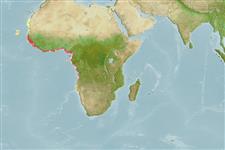Classificação / Names
Common names from other countries
Referência principal
Tamanho / Peso / Idade
Max length : 114 cm TL macho/indeterminado; (Ref. 40637); common length : 50.0 cm TL macho/indeterminado; (Ref. 3593); Peso máx. publicado: 12.0 kg (Ref. 40637)
Length at first maturity
Lm 35.0, range 28 - ? cm
Ambiente
; marinhas demersal; intervalo de profundidade 0 - 70 m (Ref. 3593)
Clima / Intervalo
Tropical, preferred 26°C (Ref. 107945); 27°N - 22°S
Distribuição
Descrição breve
Espinhos dorsais (total): 11; Raios dorsais moles (total): 28-33; Espinhos anais 2; Raios anais moles: 7. Diagnosis: large fish, elongate and compressed; eyes small; snout short; mouth large and oblique; lower jaw prominent; both jaws with bands of villiform teeth (upper jaw with teeth in outer row larger and sharper, including a pair of large median canines, lower jaw with teeth in inner row larger and sharper); 6 pores on chin and 5 marginal pores on snout; gill rakers long and slender, longer than gill filaments at angle of 1st gill arch; dorsal fin long and deeply notched; second anal fin spine rather short and slender, attaining about 2/3 of the length of 1st soft ray and comprised over 3 times in head length; caudal fin pointed; scales weakly ctenoid on body, cycloid on snout and suborbital region; lateral line extending to end of caudal fin; swim bladder carrot-shaped, its front end with a pair of appendices subdividing into an anterior group of short branches and 2 posterior groups of long, slender tubules, one of them ventral, the other dorso-lateral and longer, bordering the bladder throughout its length (Ref. 57396).
Coloration: silvery grey, with series of small dark spots following scale rows, oblique on anterior part of back and sides, horizontal posteriorly; black spot at tip of spinous part of dorsal fin; pelvics and anal fin more or less dark yellowish; caudal fin dark; inside of gill cover black (Ref. 57396).
Categoria na Lista Vermelha da IUCN (Ref. 115185)
Ameaça para o homem
Harmless
Utilização humana
Pescarias: pouco comercial; peixe desportivo: sim
Mais informação
ReferênciasAquaculturaPerfil para aquaculturaEstirpesGenéticaFrequência dos alelosHereditariedadeDoençasProcessamentoMass conversion
ColaboradoresFotografiasStamps, CoinsSonsCiguateraVelocidadeTipo de nataçãoÁrea branquialOutras referênciasCérebrosVisão
Ferramentas
Relatórios especiais
Descarregue XML
Fontes da internet
Estimates of some properties based on models
Phylogenetic diversity index
PD50 = 0.5156 many relatives (e.g. carps) 0.5 - 2.0 few relatives (e.g. lungfishes)
Nível Trófico
3.8 ±0.71 se; Based on food items.
Resiliência
Médio, tempo mínimo de duplicação da população 1,4 - 4,4 anos (K=0.33; tmax=8; assuming tm=2)
Vulnerabilidade
Moderate vulnerability (42 of 100)
Categoria de preço
